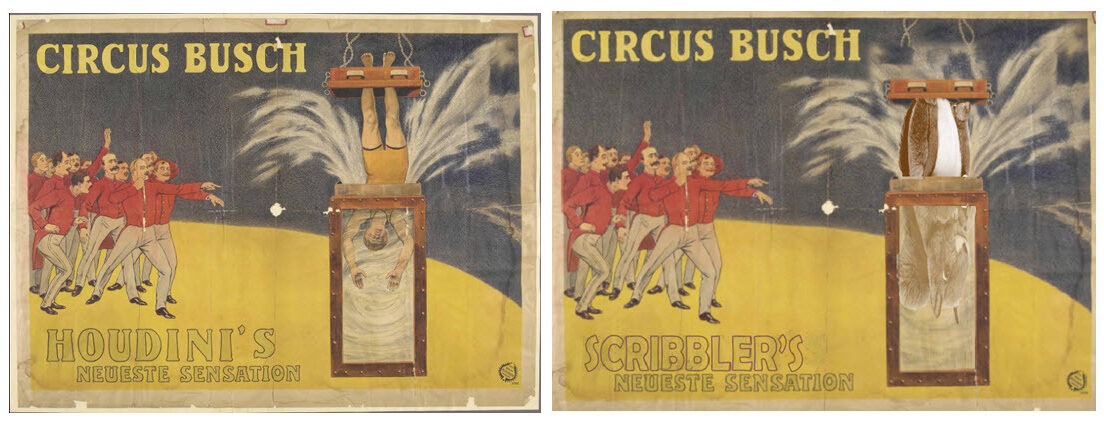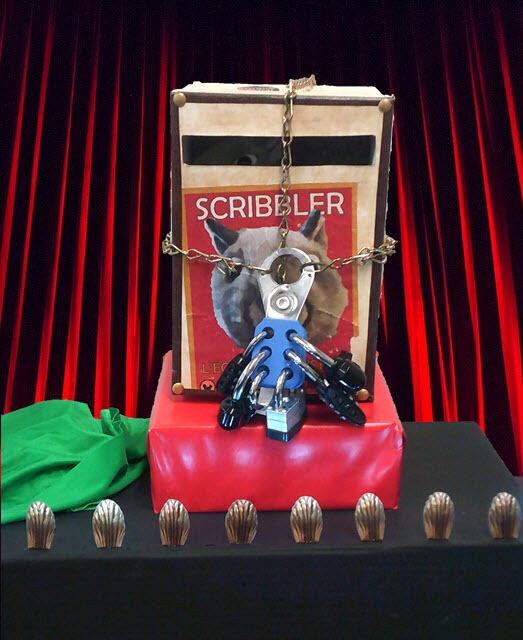"Save the Amazing Scribbler!” Using primary sources in a library escape room game
This special librarian guest blog was written by John Cosgrove and Johanna MacKay of Lucy Scribner Library at Skidmore College in Saratoga Springs, New York.

Houdini primary sources provided clues students had to solve in the game. Image © Harry Ransom Center, University of Texas, Austin. Further reproduction prohibited without permission.
What does a stuffed squirrel, an escape room and AM’s Victorian Popular Culture have in common? At Skidmore College’s Lucy Scribner Library, we combined all three – and a scavenger hunt to boot – to provide a fun, interactive library orientation for First Year Experience students.

Scribbler Squirrel is the unofficial mascot of Lucy Scribner Library at Skidmore College. He lives on the third floor of the library in his book nest and is an avid reader and researcher.
The first “Save Scribbler!” session either supplemented a traditional library instruction, or was held on its own for seminars without a formal research requirement. Working in teams against the clock, students solved clues and found keys throughout the library to free the library’s (stuffed animal) squirrel mascot, Scribbler, from a box.
This first scavenger hunt allowed students to explore the physical library and learn to use the electronic catalog. Teambuilding was a happy byproduct with most classes preferring competition over cooperation – although there was opportunity for both.
Pleased with the reception from faculty and students, we decided to incorporate databases into the second iteration of the game. As our theme coalesced around escapology and magic, it became clear that AM’s Victorian Popular Culture database would be a perfect choice for the new “Save the Amazing Scribbler!” escape room and scavenger hunt.
In the backstory to the game, Scribbler tries to emulate his hero, Harry Houdini, and accidentally locks himself inside his “Box of Doom.” Victorian Popular Culture provided authentic advertisements, which we altered to decorate Scribbler’s box and the playbill containing the game rules.
It also was the key to solving one of the clues.
Victorian Popular Culture was featured as one of two databases on the escapology/magic themed LibGuide that Scribbler conveniently assembled. Within the game, Scribbler’s Uncle Woody has sent Scribbler a note with an altered poster to show off his new Photoshop skills.
Of course, the poster is from Victorian Popular Culture.

Scribbler locked inside his “Box of Doom” unable to escape.
In order to solve the clue, the students need to find the original poster and compare it to the altered version, identifying the two words that have been changed (“famous” and “Houdini” to “nuttiest” and “Scribbler”). Having found the two original words, the students search these in the catalog to find Escape!: The Story of the Great Houdini, which provides a key to open one of the locks on the box.
Victorian Popular Culture helped give the game materials a vintage look and provided an opportunity to practice database searching. It also provided a gentle introduction to primary sources as the other database used had the students looking for secondary sources in a book review and a journal article. Since Victorian Popular Culture is primarily an archive of primary sources, it gave us a chance to make that distinction to students in a way that was engaging, entertaining and easy – and a little bit competitive!
Victorian Popular Culture is available now. For more information on this resource, including free trial access and price enquiries, please email us at info@amdigital.co.uk
Recent posts

The blog highlights American Committee on Africa, module II's rich documentation of anti-apartheid activism, focusing on the National Peace Accord, global solidarity, and student-led divestment campaigns. It explores the pivotal role of universities, protests, and public education in pressuring institutions to divest from apartheid, shaping global attitudes toward social justice and reform.

This blog examines how primary sources can be used to trace the impact of young voices on society, particularly during pivotal voting reforms in the UK and the US. Explore materials that reveal insights into youth activism, intergenerational gaps, and societal perceptions, highlighting their interdisciplinary value for studying youth culture, activism, and girlhood across history.
